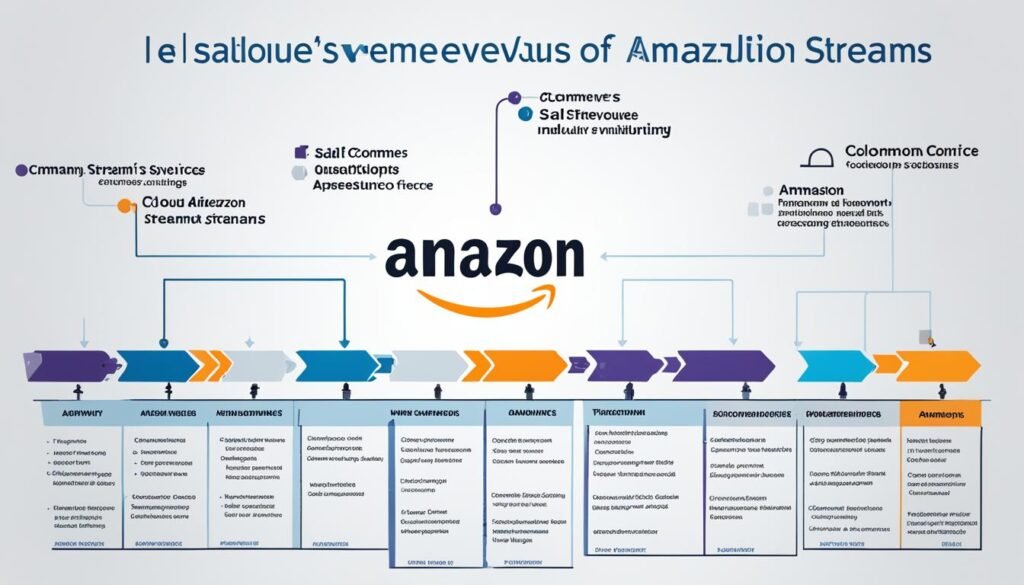Amazon, the global e-commerce giant, has established a highly diversified revenue model that encompasses various income streams. In 2022 alone, Amazon generated over half a trillion dollars in revenue, a testament to its success in the online retail industry.
The revenue breakdown reveals the extent of Amazon’s revenue diversification. Its online stores contributed a staggering $231.87 billion, while third-party seller services added over $140.05 billion to its coffers. Amazon Web Services (AWS), the company’s cloud computing division, generated $90.76 billion, highlighting its importance in Amazon’s revenue generation strategies. Advertising raked in $46.9 billion, subscription services brought in $40.21 billion, physical stores accounted for $20.03 billion, and other sources contributed $4.96 billion.
This multifaceted approach to revenue generation enables Amazon to optimize profitability. By leveraging its extensive online sales channels, comprising online stores and third-party seller services, Amazon reaches a wide customer base, fostering substantial revenue growth.
Furthermore, Amazon’s subscription services, advertising ventures, and physical stores diversify its revenue streams, allowing the company to expand its profit generation strategies effectively.
Table of Contents
ToggleKey Takeaways:
- Amazon’s revenue streams are diversified, encompassing online stores, third-party seller services, AWS, advertising, subscription services, physical stores, and other sources.
- Utilizing multiple online sales channels grants Amazon access to a vast customer base, resulting in significant revenue generation.
- Subscription services, advertising ventures, and physical stores contribute to Amazon’s overall revenue streams, enhancing its profit generation strategies.
- Amazon’s core e-commerce business often operates at a loss, while its profitability primarily stems from AWS.
- AWS plays a pivotal role in Amazon’s revenue optimization, providing monetization avenues through its reliable cloud services.
Unprofitable Core Business and the Role of AWS
Despite its massive revenue, Amazon’s core e-commerce business remains unprofitable. This can be attributed to the significant costs associated with inventory, fulfillment, and last-mile delivery. However, Amazon has found profitability in its Amazon Web Services (AWS) segment, which generated almost $23 billion in operating profit in 2022.
A detailed breakdown of Amazon’s revenue streams reveals the importance of diversification for income optimization. While its e-commerce business faces challenges in terms of profitability, AWS serves as a key revenue optimization technique, offering reliable monetization avenues through its cloud services. Embracing AWS has not only contributed to Amazon’s overall financial success but has also significantly impacted the diversification of its income streams.
“By leveraging the profitability of AWS, Amazon has been able to counterbalance any losses incurred through its core e-commerce business,” says James Thompson, an e-commerce expert.
The profitability of AWS not only strengthens Amazon’s financial position but also strengthens its ability to experiment with new market opportunities and enter different industries. This revenue diversification strategy positions Amazon for long-term success by reducing its reliance on a single income stream and broadening its revenue base.
Maximizing Revenue through AWS
Through AWS, Amazon has successfully tapped into the growing demand for cloud computing services among businesses and individuals. This has enabled the company to not only generate significant profits but also expand its capabilities beyond e-commerce.
One of the key advantages of AWS is its scalability and flexibility, allowing businesses to leverage its services based on their specific needs. By offering a wide range of cloud services, including computing power, storage, and databases, AWS caters to various industries and fosters revenue growth.
AWS’s revenue generation can be attributed to its pay-as-you-go model, which provides customers with a cost-effective solution. This flexible pricing structure enables businesses to optimize their expenses, aligning with their budget and overall growth strategy.
AWS Profitability vs. E-commerce Profitability
| Year | AWS Operating Profit (in billions) | E-commerce Operating Profit (in billions) |
|---|---|---|
| 2020 | 19.35 | -1.02 |
| 2021 | 21.81 | -0.99 |
| 2022 | 22.87 | -1.22 |
The table above illustrates the contrasting profitability trends between AWS and Amazon’s e-commerce business over the past three years. While AWS consistently generates substantial operating profits, the e-commerce segment experiences losses. This highlights the significance of AWS in Amazon’s revenue diversification strategy and underscores the e-commerce giant’s reliance on its cloud services for profitability.
- Amazon’s core e-commerce business faces challenges in achieving profitability due to high costs in inventory, fulfillment, and last-mile delivery.
- Amazon Web Services (AWS) has emerged as a profitable segment, contributing significantly to Amazon’s overall financial success.
- By diversifying its income streams and leveraging the profitability of AWS, Amazon mitigates any losses incurred through its e-commerce business.
- AWS offers a wide range of cloud services, enabling businesses to optimize costs and expand their capabilities beyond e-commerce.
- The pay-as-you-go pricing model and scalability of AWS make it an attractive choice for various industries.
Overall, the profitability of AWS plays a crucial role in Amazon’s income streams diversification and revenue optimization techniques. As the company continues to expand its range of services and explore new market opportunities, AWS remains a pivotal element in sustaining Amazon’s position as a leading player in the e-commerce and cloud computing industries.
The Potential of Transferable Network Effects
Amazon’s success can be attributed to its ability to create transferable network effects. By building a robust infrastructure and networks, Amazon has established itself as a leader in the e-commerce industry. This network effect not only sustains its existing revenue sources but also opens up opportunities for expansion into new industries. Through the transferable network effects, Amazon has the potential to redefine entire industries and ensure the longevity of its income streams.
This strategic approach to revenue sources analysis allows Amazon to adapt to changing market conditions and maintain its position as one of the world’s largest e-commerce platforms. By continually assessing its revenue sources, Amazon can identify new income streams and allocate resources accordingly to drive growth. This analytical approach ensures the diversification of its income streams and mitigates the risk associated with relying on a single source of revenue.
Moreover, the longevity of Amazon’s income streams is bolstered by its transferable network effects. These effects enable Amazon to leverage its existing customer base, technology, and infrastructure across different sectors and industries. By expanding its reach beyond traditional e-commerce, Amazon can tap into new revenue sources and capitalize on emerging market trends. This allows the company to sustain its income streams and stay ahead of the competition in an ever-evolving digital landscape.
In summary, Amazon’s success lies in its ability to harness transferable network effects, conduct thorough revenue sources analysis, and ensure the longevity of its income streams. By strategically leveraging its networks, diversifying its revenue sources, and adapting to changing market conditions, Amazon continues to dominate the e-commerce industry and reshape the business landscape.





